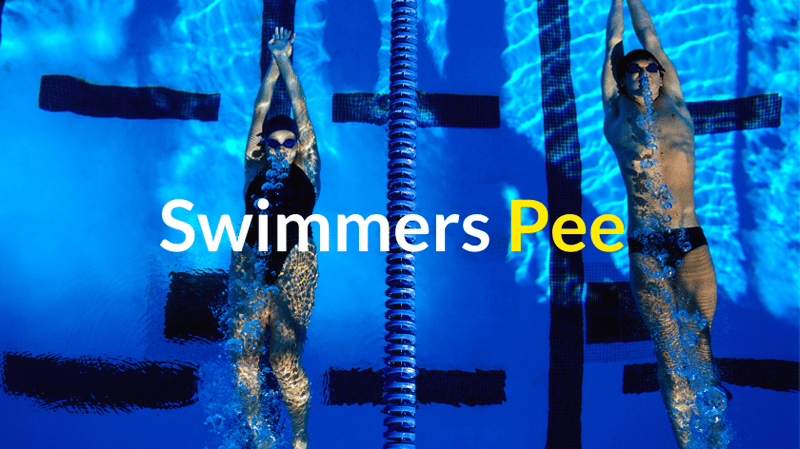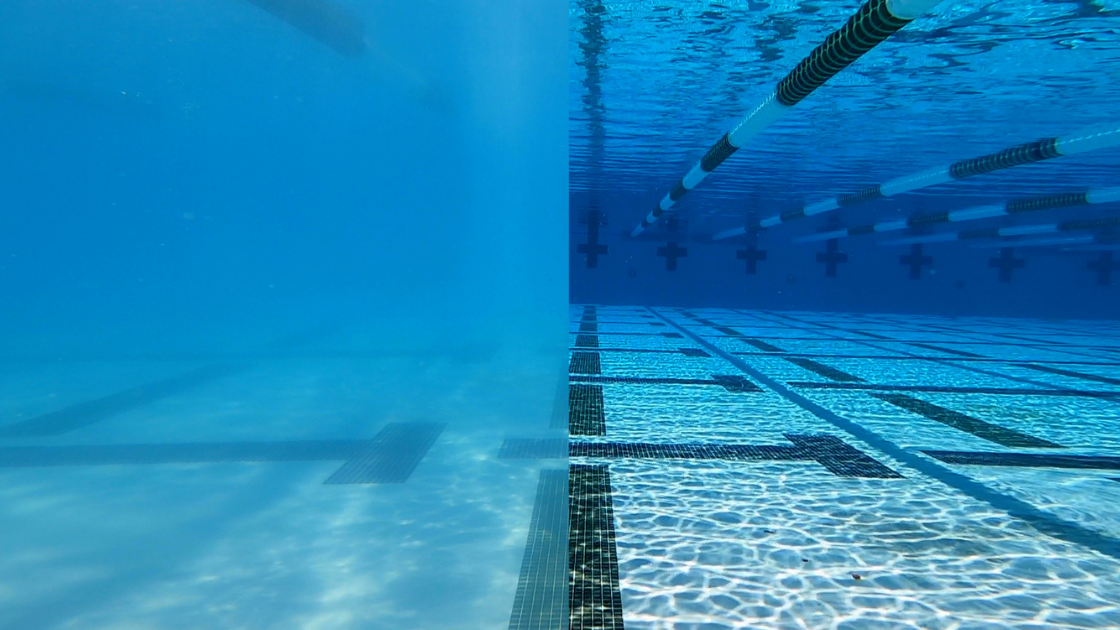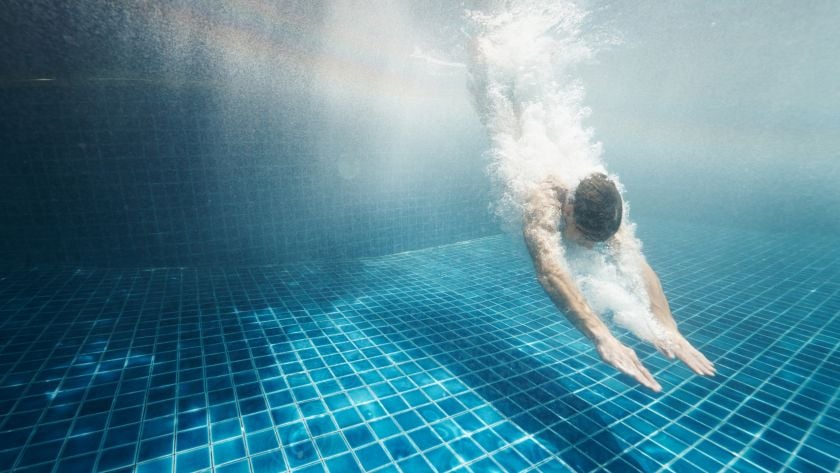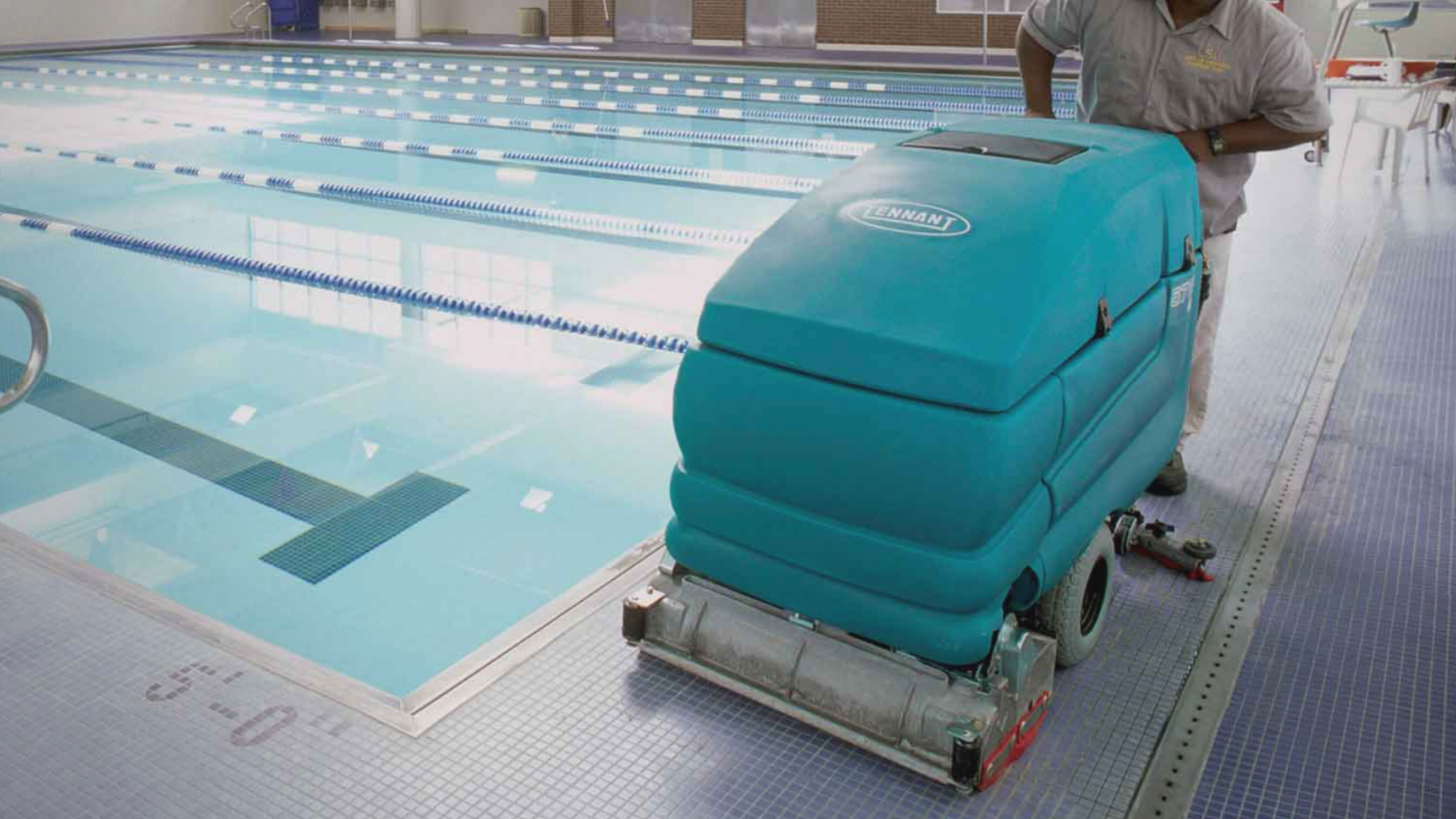Peeing in the Pool and its Consequences
Fact: competitive swimmers pee in the pool. And while it's not necessarily every swimmer, peeing in the pool is part of swimming culture. It's gross, sure. But there are valid reasons why swimmers pee without getting out of the pool. Let's discuss those reasons, the impact peeing in the pool actually has on indoor air quality, and what can be done about it.
Before going further, this article is not advocating for peeing in the pool. We argue that anything short of addressing the reasons why swimmers pee in the pool is not a viable solution; it's merely wishful thinking. Instead, we must be realists and address the water chemistry consequences as an inevitability.
The byproducts of chlorine combining with the nitrogen compounds in urine–primarily urea–are the source of bad indoor air quality for natatoriums. Monochloramine is created when chlorine (HOCl) combines with ammonia (NH3), and as more chlorine interacts with it, it becomes dichloramine and finally trichloramine, which goes airborne. Airborne chloramine vapor is the leading cause of lung conditions like lifeguard lung and general discomfort being indoors. It's also the leading cause of the pool smell, along with other disinfection byproducts (DBPs) like chloroform.
Related: Pool Water Chemistry Resources
Why swimmers pee in pools
There are legitimate reasons why competitive swimmers pee in pools. Let's discuss some of them.
Time
Swimming is a sport structured on a rigid schedule. The economic reality is that lap lane space is rented by the hour, and is often at a premium. Lanes are not cheap, and even if they were, it is rare for a group to get more than 2 hours of pool time. That means at the top the hour, the team gets in. Wasting even 5-10 minutes means burning 5-10 minutes of paid lane space, and coaches hate that. Time is crunched together because most swimmers are coming to practice either before or after school (except in the summer time). There are only so many hours before or after school, so those hours are often very busy.
Since a normal warm up set takes 20-30 minutes, the last thing a swimmer wants to do is hop out and go to the bathroom. Mainly because the momentum from warmup will be compromised, and performing in the main set will be more painful, and carries a higher risk of pulling a muscle or some other type of injury. Why? Because hopping out of the water makes you cold.
Temperature
The ideal water temperature for swimming is between 78 and 82ºF (25.5 - 28ºC), which is more than 15 degrees colder than healthy body temperature (98.6ºF, 37ºC). Warmup is an essential part of swim practice. When your body has finally adjusted to the colder water, your body is finally ready to train and perform.
Hopping out of the pool for a bathroom break can ruin all that.
Evaporative cooling is a real thing. When air moves over wet skin or hair, it accelerates evaporation, which makes you feel colder. A good example of this is human sweat, which helps our bodies cool off as it evaporates. Natatorium air temperature is ideally kept about 2ºF warmer than the water temperature, which means the air should be between 80 and 84ºF (26.6 - 28.8ºC). While this may feel warm and humid on deck for dry people, it can actually feel quite cold for wet swimmers. And going into an air-conditioned bathroom that is kept even colder can be so cold it makes your teeth chatter. Sure, it's comfortable when you're dry, but swimmers on a bathroom break are not dry.
Thirst
Swimmers lose a surprising amount of sweat during a workout. We don't necessarily feel sweaty, for obvious reasons, and that's the trap. Hydration is extremely important, because believe it or not, swimmers are notorious for being dehydrated. On our swim team, we had physiologists visit every six weeks or so to draw blood and urine samples from each of us. We already knew the importance of hydration and drank water throughout the day, and yet we were still dehydrated.
We learned that the name of the game was hydration before practice, not just during practice like we thought. And you can probably guess what happens when you swim for two straight hours after drinking a half gallon of water.
Tenacity
A huge part of competitive swimming culture is toughness. It's putting in the work, because swimming can be a tough, brutal sport. There is some peer pressure from teammates to not keep getting out for bathroom breaks. It is seen as skipping out on some of the work. Sure, coaches can build in bathroom breaks, but it's a logistical nightmare...a typical club swim team can have 6 swimmers per lane or more. What do you think happens when 30 boys and 30 girls head to the bathroom at the same time? Get real.
Here is a funny take on the problem, in defense of peeing in the pool. We agree with much of it–especially how peeing is just part of the problem. Sweat and spit are also introduced to the pool during practice, and we have already written about how unrealistic showering before swimming is. More importantly, he nails home the point about swimming culture:
"By getting out of the water for three to four minutes every single practice, one accomplishes many things in the eyes of their teammates. The first of these is making it appear that you are getting out of the pool in order to skip, since it is very unlikely that one’s teammates will assume they are trying to avoid adding more trichloramines to the pool environment. By skipping either yards or explanations from coach (which often leads to more missed yards) one can also lose the respect of their teammates. But it’s not only the others in the water that are being cheated; swimmers who skip reps for whatever reason lose the most important thing to many athletes. Gains." - Zach Breeding, SwimmingWorld Magazine
Okay, admittedly we included that quote partially because the last sentence is so spot-on it's hilarious. While his article may be partly satire, most of it is genuine and a very accurate depiction of swimming culture. Swimming culture and respect is very much tied to being able to handle the hard work. Skipping out is skipping out, even if it's for noble reasons.
Tech Suits
Finally, let's talk about high tech racing swimsuits. Sure, swim practices are not in tech suits, but swim meets are. And if you have never worn one, it is hard to describe how difficult they are to put on and take off. This video from buzzfeed shows the struggle pretty well, though these are clearly not swimmers, because their technique is all wrong:
Good luck convincing a girl who just spent 20 minutes putting on a highly compressive $400 racing suit that she should go take a bathroom break. How is she supposed to get out of her suit? These suits must be put on dry, and kept on until the session is done, because if you take off a wet suit, it's nearly impossible to put it back on without tearing it.
The argument has been made that swimmers can stand in the shower and pee, which is a fair argument. But is it realistic when the culture of swimming has made peeing in the pool so normal? Nope.
Does peeing in the pool impact air quality?
Yes, peeing in the pool will negatively impact indoor air quality, but urine is not the only contributing factor. Urea is also found in sweat, for instance. Since swimmers sweat so much during practice, sweat cannot be a discounted factor. Urine has a much higher concentration of urea than sweat does, but generally a swimming pool will have more sweat in it than urine after a swim practice. The factor is unknown and difficult to measure, but we bring it up just to illustrate a point.

As nice as it would be if swimmers would stop peeing in the pool, how can you restrict sweat? Sure, any little bit helps, so showering before swimming and not peeing in the pool give chlorine less nitrogen to oxidize. There is a reason seemingly every scientist involved with this issue brings up urine in pools as a source of the problem. We just want to remind you about reality.
One person peeing in a 250,000 gallon (946 m3) swimming pool will not make or break the air quality for the entire natatorium. What actually occurs is persistent contamination that eventually overwhelms chlorine, and causes it to fall behind. When the pollution rate exceeds the oxidation rate, the problems will compound, and manifest themselves as high combined chlorine and bad indoor air quality.
Another concern with persistent loading of nitrogen compounds into water is the formation of nitrates. All that urea and ammonia in water will eventually be oxidized by chlorine and converted into nitrate, all at the expense of free chlorine. According to the IPSSA Intermediate Training manual by Robert W. Lowry, here's the chemical progression:1
Urea's Reaction with Chlorine
Urea + HOCl → N-chlorourea + H2O
N-chlorourea + HOCl → N,N'-dichlorourea + H2O
N,N'-dichlorourea + HOCl → N,N,N'-trichlorourea + H2O
N,N,N'-trichlorourea + HOCl → N,N,N,N'-tetrachlorourea + H2O
N,N,N,N'-tetrachlorourea + HOCl → H+ + Cl- + NCl3 + (N-Cl)
(N-Cl) + (OH-) → NOH (nitroxyl radical) + Cl-
2NOH → H2N2O2 (hyponitrous acid)
H2N2O2 → N2O + H2O
NCl3 + HOCl + 2H2O → NO3- + 4Cl- + 5H+
On the final line, that's trichloramine (nitrogen trichloride) plus free chlorine and water, which yields nitrate, four chlorides and five hydrogens. Yikes, that's some complex chemistry. We spent the past 25 minutes typing that and double checking it to make sure we had it right. And we did that to illustrate just how complicated the oxidation process of urea actually is. It takes five units of Hypochlorous acid (HOCl, the strong form of free chlorine) to break down a urea into a form that eventually creates nitrate (NO3-), which is the final stage of nitrogen in water. In other words, nitrogen cannot be oxidized any further, so nitrates stay in water until drained out or filtered using reverse osmosis.
Unfortunately, dealing with nitrogen compounds is inevitable. To quote Lowry again:
"Dealing with chloramines or combined chlorine in recreational water is an endless, difficult and not well understood practice. It is inevitable that you will get ammonia or nitrogen compounds [like urea] in the water. Therefore you must deal with them as they are introduced, AND after they have combined with chlorine. Most pools deal with chlorine-reducing organic nitrogen compounds after they are formed rather than when they are introduced" - Page 67
Amen, Dr. Lowry. It is inevitable that nitrogen compounds will get in the water. Even if swimmers are not peeing, they're still sweating. Therefore we must deal with these compounds. He summarized our position well. He also mentions most pools deal with these compounds after they are formed, meaning after they have combined with chlorine. This is a nod to UV systems, since they cannot oxidize things like urea, but can break down formed chloramines.
So peeing in the pool puts nitrogen in the water that will add to chlorine's oxidant demand, but it takes a lot of urine to make the indoor air quality of a natatorium go south. Either way, we have to address it once it's in the pool.
How to address urine in swimming pools
Urine is sterile, so there should be nothing for chlorine to "kill". Instead, urine must be oxidized. One chemical in urine is particularly difficult to oxidize: urea, or uric acid. Urea (CH4N2O) will break down into other nitrogen compounds like ammonia, which will combine with chlorine to form chloramines. So the objective of addressing urine in swimming pools comes down to how well the pool can break down urea and other nitrogen compounds. In other words, how well a pool operator can supplement chlorine against these non-living contaminants.
Chemicals that can help against urine
As of now, we do not know of a chemical or enzyme that can safely break down nitrogen compounds. The only ones we have seen are a type of bacteria that can only survive if the pool is completely dechlorinated, which renders them irrelevant in a swimming pool.
 We can, however, use enzymes to address carbon-based compounds, also known as non-living organics. These organics include sweat, urine and body oils (except for the nitrogen components), and bather products like cosmetics, lotions, deodorants and sunscreen. Non-living organics account for a clear majority of a swimming pool's oxidant demand. In other words, most of chlorine's burden is to oxidize and remove non-living organics, and chlorine is not designed for that job. Rather, chlorine is designed to be a great disinfectant, killing diseases, viruses and microorganisms like algae.
We can, however, use enzymes to address carbon-based compounds, also known as non-living organics. These organics include sweat, urine and body oils (except for the nitrogen components), and bather products like cosmetics, lotions, deodorants and sunscreen. Non-living organics account for a clear majority of a swimming pool's oxidant demand. In other words, most of chlorine's burden is to oxidize and remove non-living organics, and chlorine is not designed for that job. Rather, chlorine is designed to be a great disinfectant, killing diseases, viruses and microorganisms like algae.
An important thing to note here is that non-living organics themselves do not necessarily contribute to combined chlorine or chloramine byproducts. Only those that contain nitrogen will add to the combined chlorine level.
Related: How to Reduce Combined Chlorine
Pools can also periodically super-chlorinate to if the pool is struggling to achieve breakpoint chlorination.
Secondary Oxidation Systems
Another great supplement to chlorine is a secondary disinfection and oxidation system. We have another article comparing secondary systems that show you the pros and cons of each system. In short, UV can destroy formed Monochloramines, but cannot oxidize urea or other precursors. Ozone, however, can easily destroy urea, ammonia, and just about any other oxidant that would be found in swimming pool water. AOP is another type of secondary oxidizer that can also help, and so is hyper-dissolved oxygen (HDO).
With the exception of HDO, all of these systems are limited in their reach, because they are point-of-contact systems. Meaning they only treat water that passes through their chamber, or past their area of influence. Basically, they only treat water that passes through the pump room, and do not have much (if any) residual benefits out in the swimming pool itself.
Conclusion
When secondary systems like ozone and UV are used in conjunction with enzymes, chlorine has two valuable allies in its war against contamination. Freeing up chlorine from having to oxidize everything means it can focus more on what it does best: kill germs.
So while it would be nice if swimmers would not pee in the pool, it's wishful thinking. Until the legitimate reasons for avoiding bathroom breaks are addressed, swimmers will continue to pee, and pool operators need to be prepared for it. It's inevitable.
Perhaps there could be on-deck showers with a privacy wall that swimmers could step behind and pee while staying in their suits. At least they could avoid having to go into the colder locker room, and the coaches and teammates would know it was a legitimate bathroom break, instead of someone disappearing for a couple of minutes, possibly skipping out on parts of the main set.
Address the cultural and physical reasons why swimmers pee in the pool, or you will never address the problem.
1 Source: Lowry, Robert W., IPSSA Intermediate Training Manual, 2009. Page 65

 By
By


